Experimental Investigation and Numerical Simulation of Corrugated Steel Plate Shear Wall Considering the Gravity Load
Abstract
:1. Introduction
2. Experimental Design
3. Experimental Results
3.1. Hysteretic Curve
3.2. Envelope Curves
3.3. Specimens’ Behaviour
4. Numerical Simulation
4.1. Numerical Model and Verification
4.2. Parametric Analysis
4.3. Infill Steel Plate
4.4. Vertical Load
5. Conclusions
- The corrugation of SPSWs increases the shear deformation adaptability. For the corrugated SPSWs, the shear–displacement curve has a small yield plateau formed by the gradual flattening of the corrugations.
- A numerical model was proposed to simulate the SPSWs with the actual gravity load, and the effectiveness of the proposed model was validated by the experimental results.
- Considering the gravity load, the yield force of the vertical CSPSW (VT4), horizontal CSPSW (HT4), and flat SPSW (FT4) were 1005.75 kN, 851.66 kN, and 708.6 kN, respectively. The performance of the vertical CSPSW may be better than the horizontal CSPSW and flat SPSW. Comparing the shear displacement relation shape of different infill plate types, the effect of the vertical load to simulate the actual gravity load on the horizontal CSPSW is the largest, followed by the flat SPSW and the vertical CSPSW.
- The shear–displacement curve of the CSPSWs experienced three stages including an elastic stage, a decrease stage, and an increase stage. For vertical CSPSWs with a small height-to-thickness ratio, such as VT6, the shear–displacement curve has a stable post-buckling stage.
Author Contributions
Funding
Institutional Review Board Statement
Informed Consent Statement
Data Availability Statement
Conflicts of Interest
References
- Guo, Y.-l.; Zhu, J.-s. Research progress of shear walls: Types and design methods. Eng. Mech. 2020, 37, 19–33. (In Chinese) [Google Scholar]
- Berman, J.W.; Bruneau, M. Experimental Investigation of Light-Gauge Steel Plate Shear Walls. J. Struct. Eng. 2005, 131, 259–267. [Google Scholar] [CrossRef] [Green Version]
- Emami, F.; Mofid, M.; Vafai, A. Experimental study on cyclic behavior of trapezoidally corrugated steel shear walls. Eng. Struct. 2013, 48, 750–762. [Google Scholar] [CrossRef]
- Qiu, J.; Zhao, Q.H.; Yu, C.; Li, Z. Experimental Studies on Cyclic Behavior of Corrugated Steel Plate Shear Walls. J. Struct. Eng. 2018, 144, 04018200. [Google Scholar] [CrossRef]
- Ding, Y.; Deng, E.-f.; Zong, L.; Dai, X.; Lou, N.; Chen, Y. Experimental study on seismic performance of corrugated steel plate shear wall in modular container construction. J. Build. Struct. 2018, 39, 110–118. (In Chinese) [Google Scholar]
- Cao, Q.; Huang, J. Experimental study and numerical simulation of corrugated steel plate shear walls subjected to cyclic loads. Thin-Walled Struct. 2018, 127, 306–317. [Google Scholar] [CrossRef]
- Wang, W.; Luo, Q.; Sun, Z.; Wang, B.; Xu, S. Relation analysis between out-of-plane and in-plane failure of corrugated steel plate shear wall. Structures 2021, 29, 1522–1536. [Google Scholar] [CrossRef]
- Yadollahi, Y.; Pakar, I.; Bayat, M. Evaluation and comparison of behavior of corrugated steel plate shear walls. Lat. Am. J. Solids Struct. 2015, 12, 763–786. [Google Scholar] [CrossRef] [Green Version]
- Dou, C.; Jiang, Z.; Pi, Y.; Guo, Y. Elastic shear buckling of sinusoidally corrugated steel plate shear wall. Eng. Struct. 2016, 121, 136–146. [Google Scholar] [CrossRef]
- Zhao, Q.; Sun, J.; Li, Y.; Li, Z. Cyclic analyses of corrugated steel plate shear walls. Struct. Des. Tall Spec. Build. 2017, 26, e1351. [Google Scholar] [CrossRef]
- Farzampour, A.; Laman, J.A.; Mofid, M. Behavior prediction of corrugated steel plate shear walls with openings. J. Constr. Steel Res. 2015, 114, 258–268. [Google Scholar] [CrossRef]
- Farzampour, A.; Mansouri, I.; Hu, J.W. Seismic Behavior Investigation of the Corrugated Steel Shear Walls Considering Variations of Corrugation Geometrical Characteristics. Int. J. Steel Struct. 2018, 18, 1297–1305. [Google Scholar] [CrossRef]
- Deng, E.; Zong, L.; Wang, H.; Shi, F.; Ding, Y. High efficiency analysis model for corrugated steel plate shear walls in modular steel construction. Thin-Walled Struct. 2020, 156, 106963. [Google Scholar] [CrossRef]
- Zhao, Q.; Qiu, J.; Zhao, Y.; Yu, C. Estimating Fundamental Period of Corrugated Steel Plate Shear Walls. KSCE J. Civ. Eng. 2020, 24, 3023–3033. [Google Scholar] [CrossRef]
- Feng, L.; Sun, T.; Ou, J. Elastic buckling analysis of steel-strip-stiffened trapezoidal corrugated steel plate shear walls. J. Constr. Steel Res. 2021, 184, 106833. [Google Scholar] [CrossRef]
- Tan, P.; Wei, Y.; Li, Y. Experimental investigation on performance of corrugated steel plate shear wall. China Civ. Eng. J. 2018, 51, 8–15. [Google Scholar]
- Tan, P.; Zhou, L.-l.; Teng, X.-f. Hysteretic performance of self-centering steel frame with semicircular corrugated steel plate shear wall with edge stiffeners. J. Build. Struct. 2021, 42, 185–192. (In Chinese) [Google Scholar]
- Wang, W.; Ren, Y.; Lu, Z.; Song, L.; Han, B.; Zhou, Y. Experimental study of the hysteretic behaviour of corrugated steel plate shear walls and steel plate reinforced concrete composite shear walls. J. Constr. Steel Res. 2019, 160, 136–152. [Google Scholar] [CrossRef]
- Broujerdian, V.; Ghamari, A.; Abbaszadeh, A. Introducing an efficient compound section for steel shear wall using flat and corrugated plates. Structures 2021, 33, 2855–2871. [Google Scholar] [CrossRef]
- Ghodratian-Kashan, S.M.; Maleki, S. Numerical Investigation of Double Corrugated Steel Plate Shear Walls. J. Civ. Eng. Constr. 2021, 10, 44–58. [Google Scholar] [CrossRef]
- Ma, X.; Hu, Y.; Jiang, L.; Jiang, L.; Nie, G.; Zheng, H. Study on the Seismic Performance of stiffened corrugated steel plate shear walls with atmospheric corrosion. Materials 2022, 15, 4920. [Google Scholar] [CrossRef] [PubMed]
- Yang, L. Steel Plate Shear Walls with Gravity Load: Theory and Design; Springer: Singapor, 2022. [Google Scholar]
- GB/T2975-2018; Steel and Steel Products-Location and Preparation of Test Pieces for Mechanical Testing. China Standards Press: Beijing, China, 2018. (In Chinese)
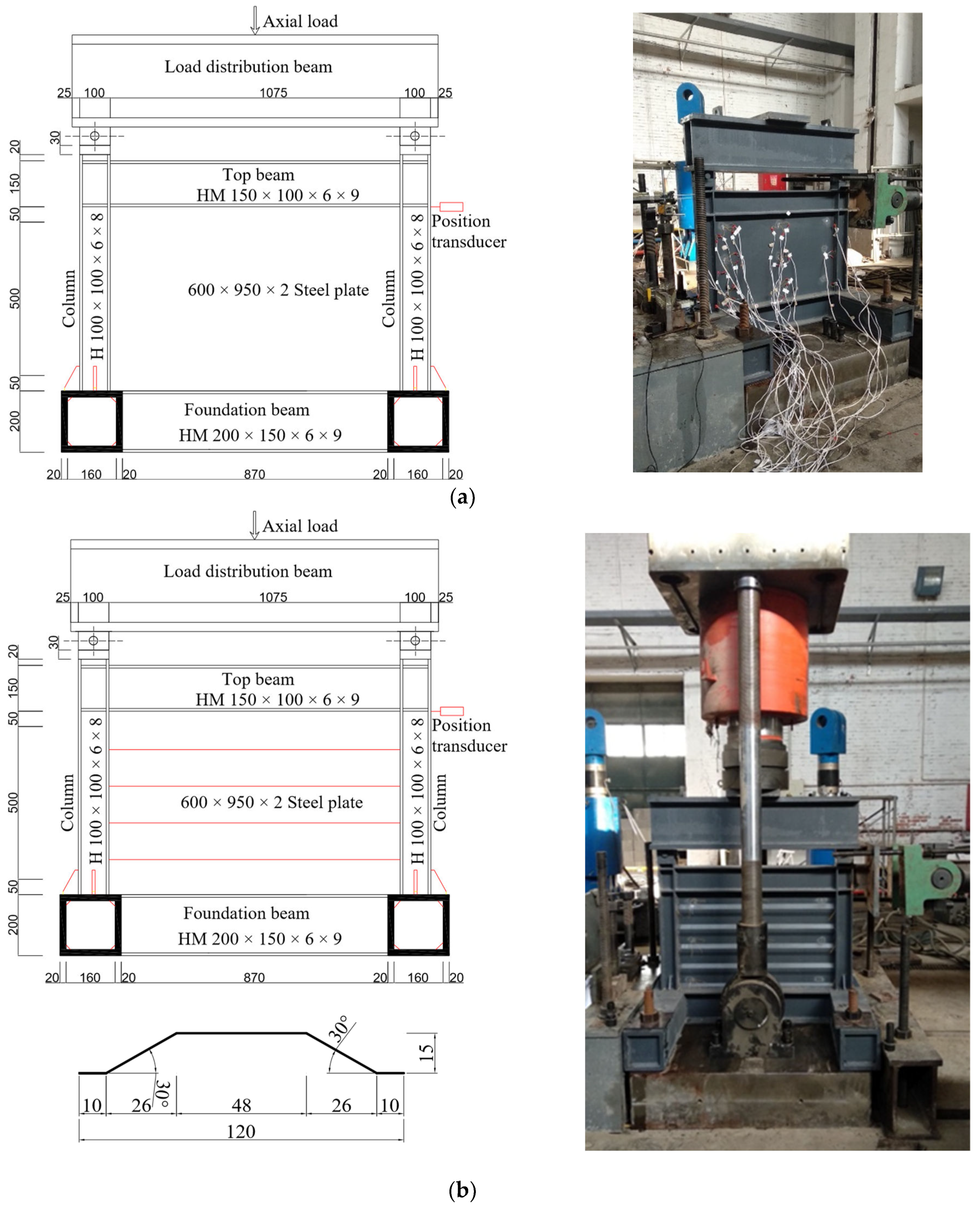
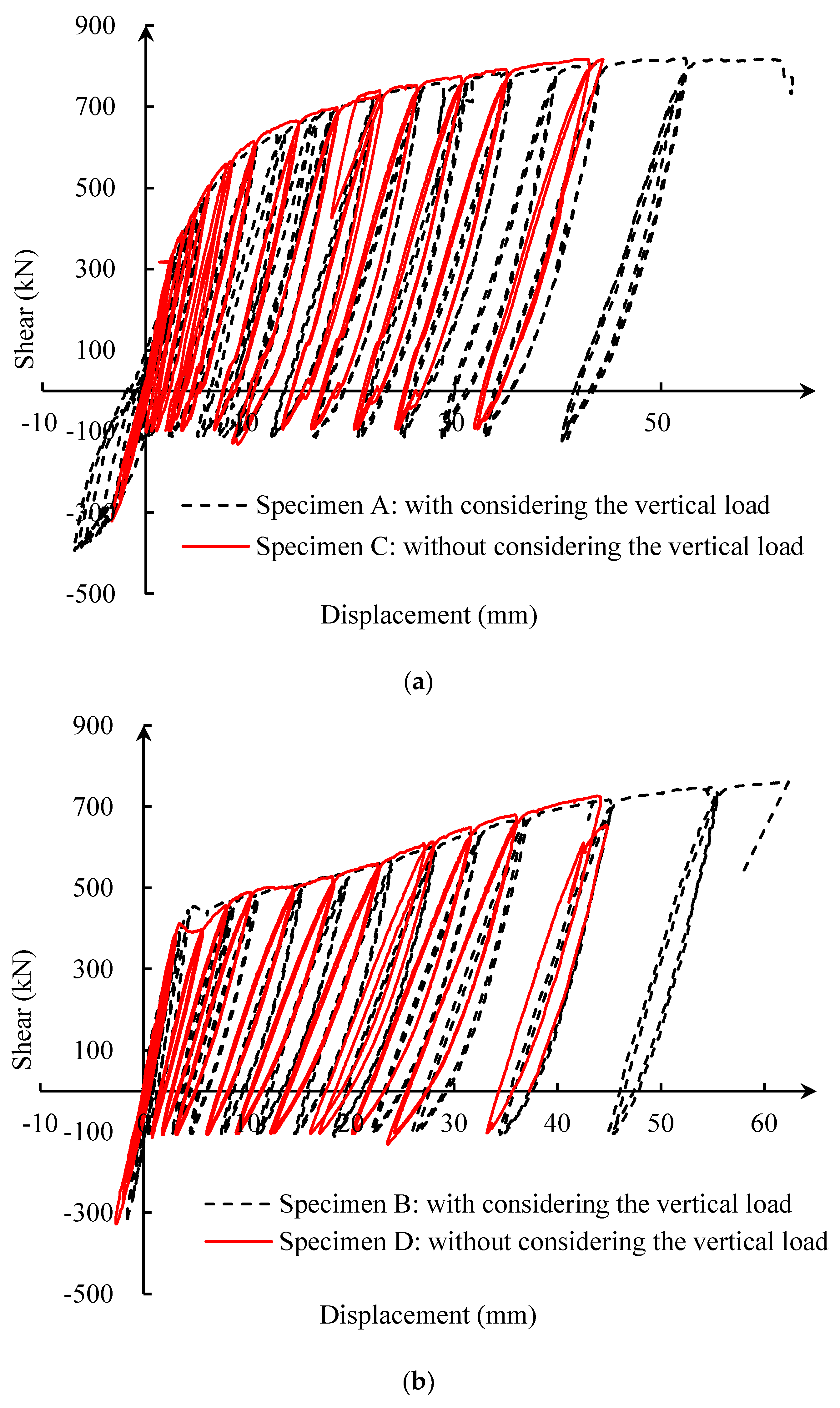
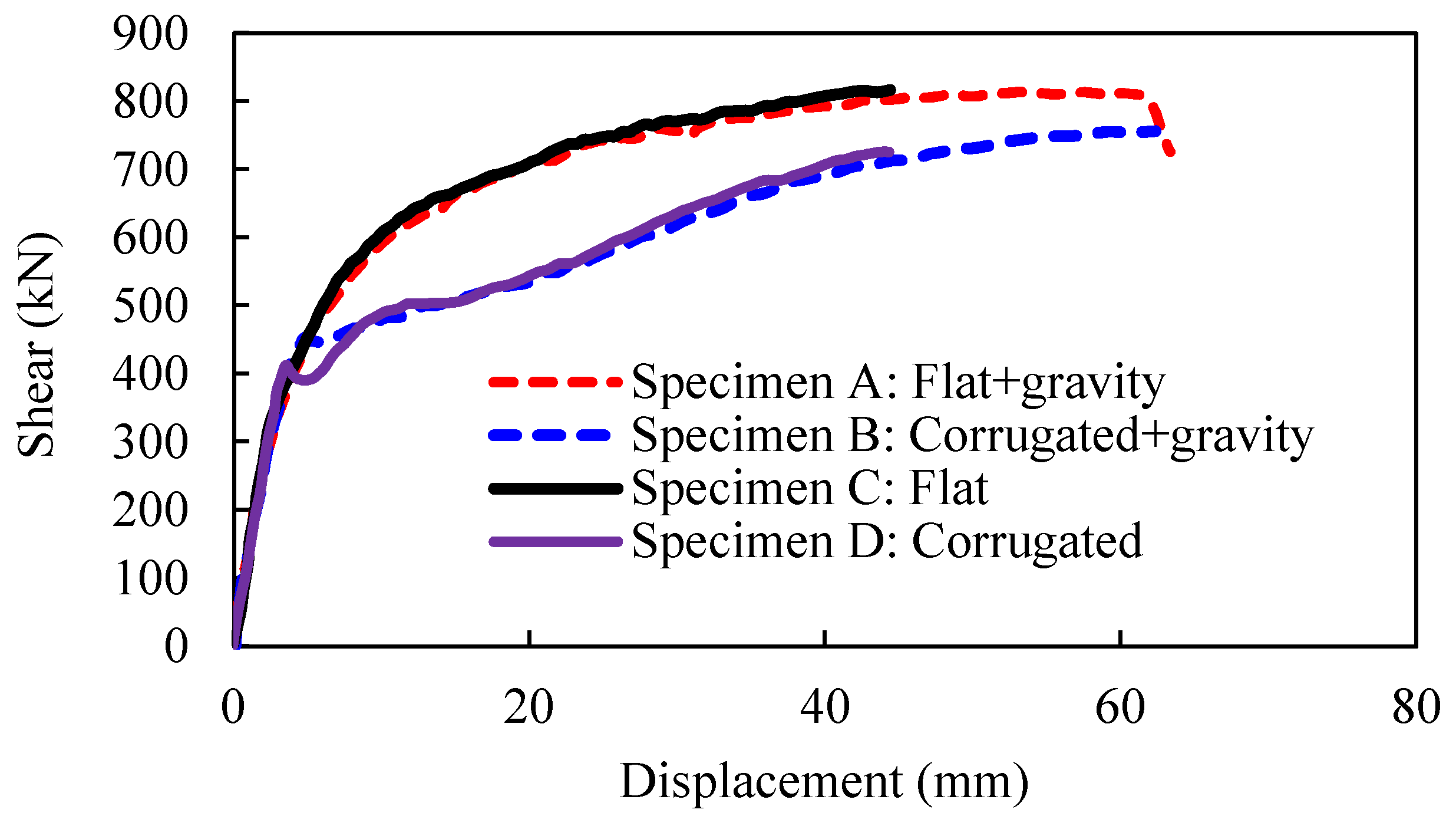
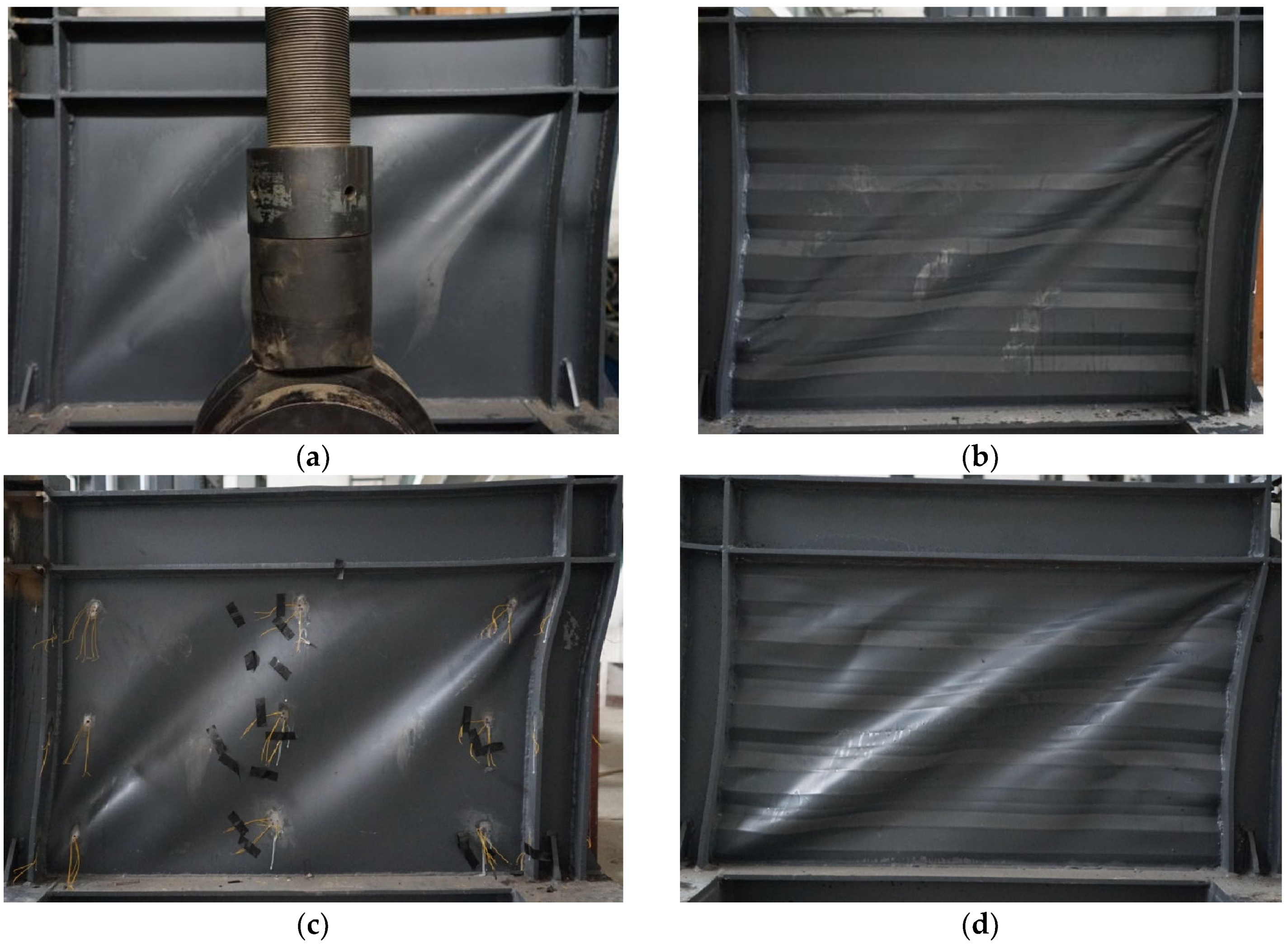
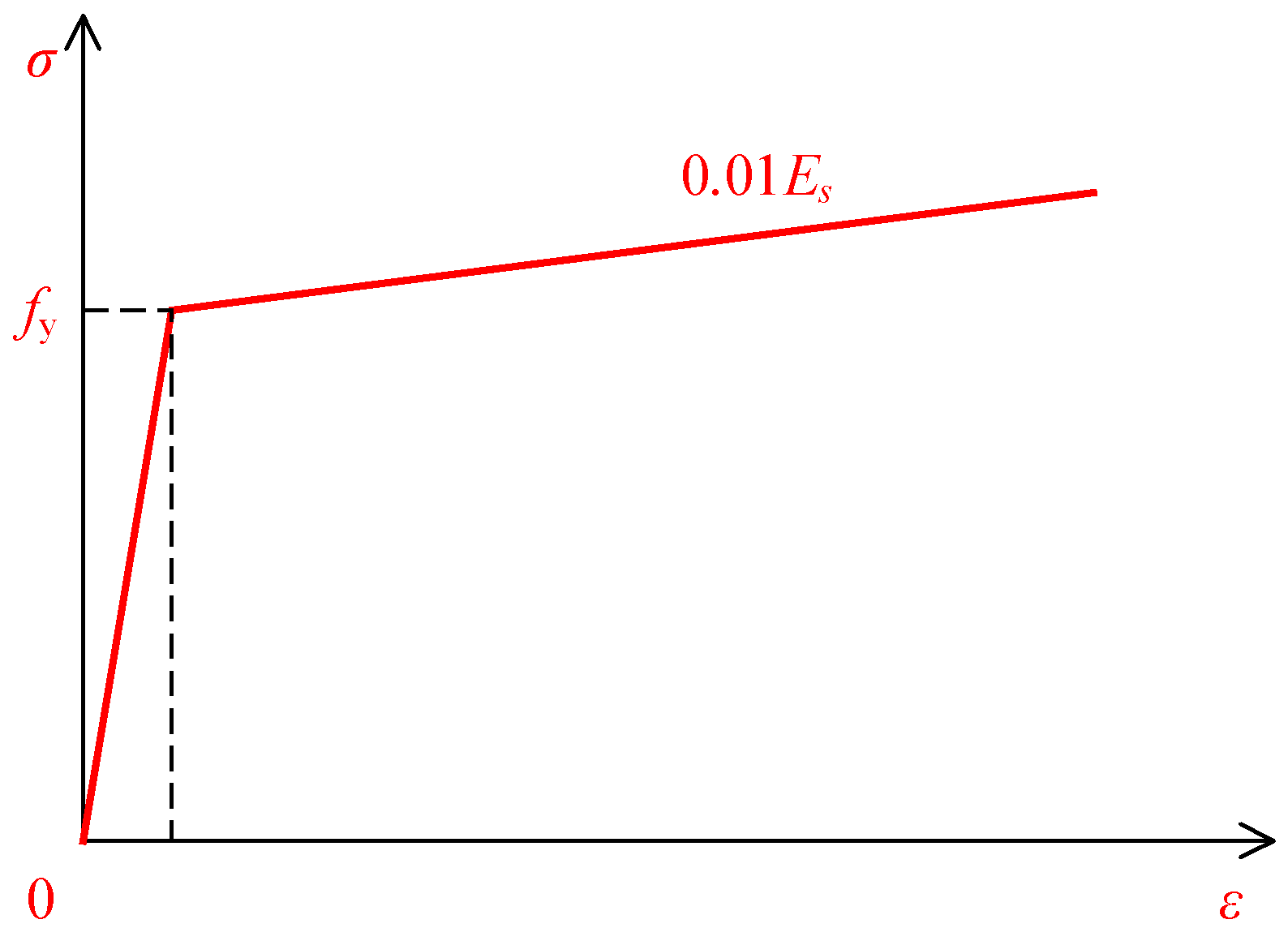





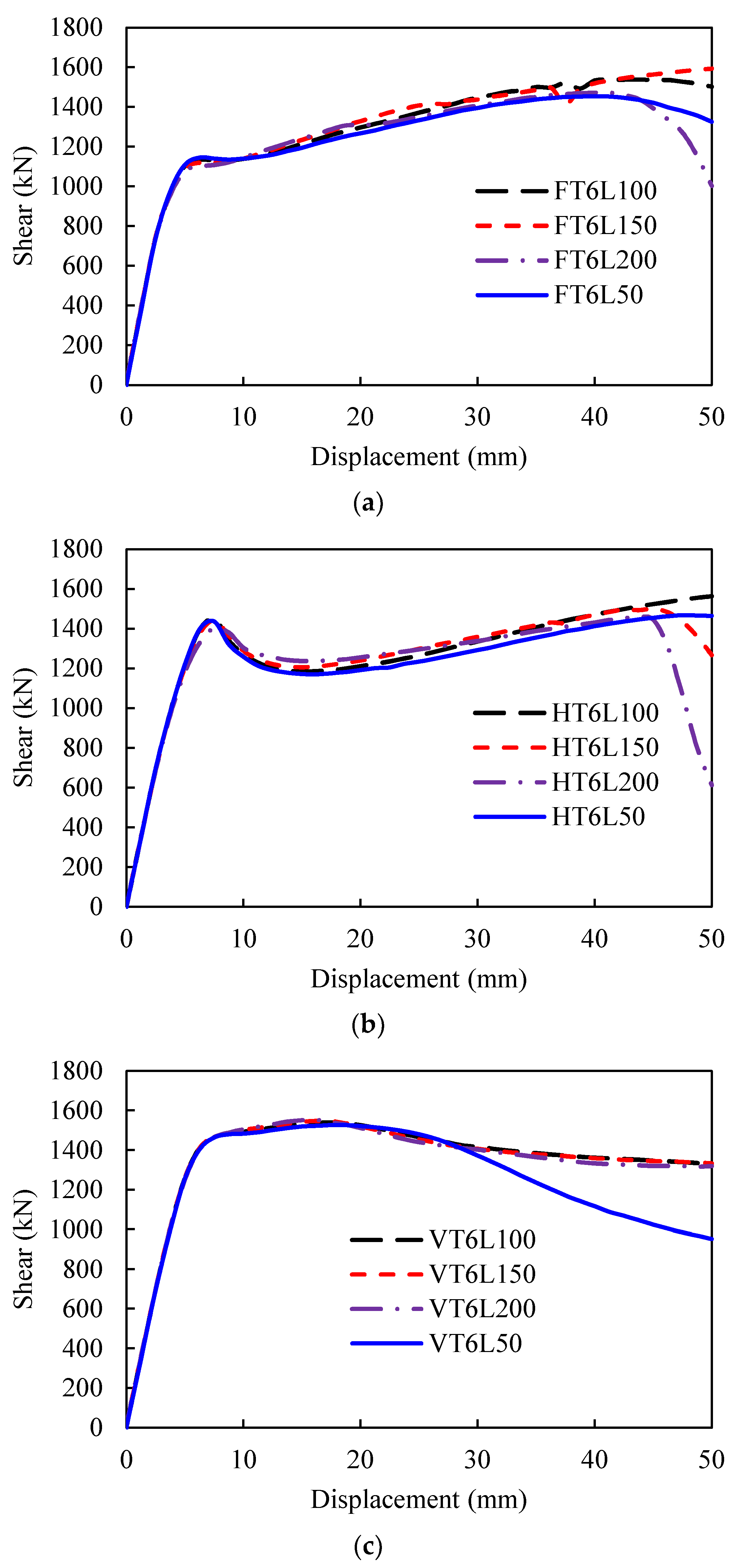


| Specimen | Configuration | Plate Thickness (mm) | Plate Size (mm) | Top Beam | Column |
|---|---|---|---|---|---|
| A | flat steel plate | 2 | 600 × 950 | HM150 × 100 × 6 × 9 | H100 × 100 × 6 × 8 |
| B | corrugated steel plate | 2 | 600 × 950 | HM150 × 100 × 6 × 9 | H100 × 100 × 6 × 8 |
| C | flat steel plate | 2 | 600 × 950 | HM150 × 100 × 6 × 9 | H100 × 100 × 6 × 8 |
| D | corrugated steel plate | 2 | 600 × 950 | HM150 × 100 × 6 × 9 | H100 × 100 × 6 × 8 |
| Steel | Thickness (mm) | Yield Stress (MPa) | Ultimate Stress (MPa) | Elongation |
|---|---|---|---|---|
| Q235 | 2 | 232 | 376 | 18.3 |
| Q390 | 5 | 456 | 562 | 21.4 |
| Q390 | 10 | 456 | 562 | 21.4 |
| Specimen | Plate Type | Vertical Load | K0 (kN/mm) | Py (kN) | dy (mm) | θy | Pmax (kN) | dmax (mm) | θmax | μ |
|---|---|---|---|---|---|---|---|---|---|---|
| A | Flat | With gravity | 164 | 507.8 | 6.75 | 1.038 | 813.5 | 63.33 | 9.743 | 9.38 |
| B | Corrugated | With gravity | 157 | 453.1 | 4.79 | 0.737 | 756.3 | 62.34 | 9.591 | 13.01 |
| C | Flat | Without gravity | 152 | 520.5 | 6.58 | 1.012 | 817.0 | 44.38 | 6.828 | 6.74 |
| D | Corrugated | Without gravity | 149 | 412.4 | 3.51 | 0.540 | 726.0 | 44.32 | 6.818 | 12.63 |
| Plate Type | Notation | Thickness t (mm) | Axial Load p (MPa) |
|---|---|---|---|
| Flat | FTtLp | 2/4/6 | 50/100/150/200 |
| Horizontal corrugated | HTtLp | ||
| Vertical corrugated | VTtLp |
| Walls | 50 MPa | 100 MPa | 150 MPa | 200 MPa | |||
|---|---|---|---|---|---|---|---|
| Shear | Shear | Decrease | Shear | Decrease | Shear | Decrease | |
| FT2 | 389.48 | 408.13 | 4.79% | 394.83 | 1.37% | 378.7 | −2.77% |
| FT4 | 722.68 | 708.6 | −1.95% | 639.9 | −3.98% | 675.04 | −6.59% |
| FT6 | 1109.35 | 1103.58 | −0.52% | 1091.88 | −1.57% | 1076.53 | −2.96% |
| HT2 | 410.63 | 408.27 | −0.57% | 404.54 | −1.48% | 401.04 | −2.34% |
| HT4 | 853.28 | 851.66 | −0.19% | 845.89 | −0.87% | 834.88 | −2.16% |
| HT6 | 1435.97 | 1449.47 | 0.94% | 1442.13 | 0.43% | 1403.93 | −2.23% |
| VT2 | 509.82 | 508.31 | −0.30% | 502.93 | −1.35% | 495.89 | −2.73% |
| VT4 | 1004.25 | 1005.75 | 0.15% | 1004.86 | 0.06% | 1001.07 | −0.32% |
| VT6 | 1257.83 | 1262.97 | 0.41% | 1263.67 | 0.46% | 1255.4 | −0.19% |
Disclaimer/Publisher’s Note: The statements, opinions and data contained in all publications are solely those of the individual author(s) and contributor(s) and not of MDPI and/or the editor(s). MDPI and/or the editor(s) disclaim responsibility for any injury to people or property resulting from any ideas, methods, instructions or products referred to in the content. |
© 2023 by the authors. Licensee MDPI, Basel, Switzerland. This article is an open access article distributed under the terms and conditions of the Creative Commons Attribution (CC BY) license (https://creativecommons.org/licenses/by/4.0/).
Share and Cite
Li, F.; Gao, J.; Zhang, Y.; Chen, Y.; Lv, Y. Experimental Investigation and Numerical Simulation of Corrugated Steel Plate Shear Wall Considering the Gravity Load. Buildings 2023, 13, 346. https://doi.org/10.3390/buildings13020346
Li F, Gao J, Zhang Y, Chen Y, Lv Y. Experimental Investigation and Numerical Simulation of Corrugated Steel Plate Shear Wall Considering the Gravity Load. Buildings. 2023; 13(2):346. https://doi.org/10.3390/buildings13020346
Chicago/Turabian StyleLi, Fangfang, Junjie Gao, Yu Zhang, Yu Chen, and Yang Lv. 2023. "Experimental Investigation and Numerical Simulation of Corrugated Steel Plate Shear Wall Considering the Gravity Load" Buildings 13, no. 2: 346. https://doi.org/10.3390/buildings13020346





